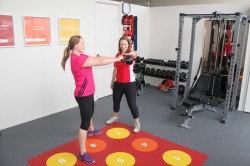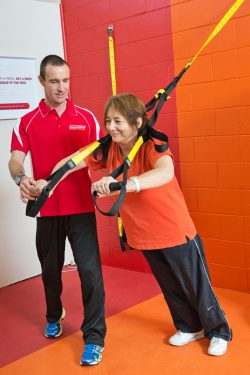We’ve all heard the expression ‘functional training’, but what does it really mean? Technically speaking, functional training is exercise that helps prepare a person for activities performed in their daily life. What is ‘functional’ for one person might not necessarily be functional for another person depending on what activities/sports/work they perform on a daily basis. For example:
- A plasterer might do a lot of work standing on a ladder, bending down, twisting, and reaching up overhead, so a lot of balancing, bending, twisting and overhead exercises would be functional training for his work.
- A volleyball player needs to do a lot of jumping and high impact movements, so a lot of jump/plyometric training would be functional for her sport.
- A person recovering from bad back might be struggling to get up and down from a chair without help, so lots of simplified and assisted versions of squats focusing on posture and correct hip flexion would be functional.
Some fantastic functional movements that use a lot of muscles and joints – as well as burning a lot more calories include things like:
- Squats, lunges, step ups
- Boxing, kicking
- Pushups, chest press
- Rows, pull ups
- Rotations, flexions, bends
- Balance and agility work
- Combination movements incorporating multiple of the above.
Lots of exercises would be appropriate for our plasterer or volleyball player examples, but either not appropriate, or require a heavily modified version for our bad back example. There’s so much variety out there and so many options for each unqiue individual, you can see a few hundred of our favourites in our workout videos here.
What is NOT functional
What is NOT generally functional is sitting down on a machine and isolating one muscle at a time. Consider how the body works in real life. Every movement that we make involves multiple joints and muscles working together in unison to create fluid movements. Walking, climbing stairs, bending over, getting in and out of the car, putting something on the top shelf, picking up the kids and carrying them – it’s ALWAYS compound movements.
Most traditional gym settings have dozens of different machines all designed to isolate one joint/muscle group at a time. Leg extensions, ham curls, bicep curls, tricep extensions, pec dec, hip abduction/adduction – none of these machine replicate movements that occur in real life. Most real life movements involve compound push and compound pull of the shoulder and elbow, rotation and bending of the torso and triple extension at the hip, knee and ankle, as well as engaging your core to assist with balance and involving proprioception.
Now we’re not saying that you should NEVER do any isolation exercises, they certainly have their place in rehabilitation and for occasional variety. Plus some people simply do have the goal of big biceps, so isolation exercises can be great for building one specific muscle. However in a real world setting, most of us need to prepare our bodies for compound movements, and so compound exercises are much more functional. The good news is; you don’t need any big, expensive equipment to train in a functional manner! Most of our Trainers carry a few dumbbells, a suspension trainer, some ropes, balls, boxing gear and resistance bands – and combined with your body weight, you have everything you need to get an amazing, functional work out!
What SHOULD NOT be called functional

Which functional exercises should YOU do?
There’s no easy answer to this, especially when there’s different ages, sizes, goals and abilities of people reading this. We go through these answers in depth with our one on one clients. But the good news is you don’t need to be a qualified Personal Trainer to get some of the answers yourself. Simply ask yourself, or anyone training you: How’s does this exercise help me safely and effectively replicate what I’m training for? If you can’t figure it out, odds are it’s not functional for you.

